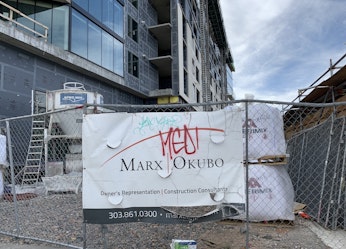

M|O Perspectives
Check back here for our thoughts on the latest developments in our industry.
Still processing. Still learning. Still standing.
May 06, 2020
Like our banner on the fence of a Denver construction site, we (and likely everyone we all know) would have the current caption: “Maybe a little battered and bruised, but definitely still standing.”
Wow, looking back now, who saw this—and to this degree—coming, just two months ago? Really, none of us.
It's always hard to take any blows when you may be anticipating them even a little, but it's even harder when we are all feeling sucker-punched in so many ways. After it is over—and, importantly, you either don’t get knocked down, or, you rise again (and you will)—you know how to better prepare for a whole new host of possibilities.
Come on. We know earthquakes are expected on the west coast but not in Missouri **. Though after the shaking stops for all of us, suddenly we are imbued with so much more. Always with valuable lessons and insight/hindsight, we’re in a much better position to describe what we are expecting in the future and what to do about it to improve our resilience.
The last six to seven weeks especially have reinforced for us how important it is to find the good in things, the stuff that makes the load a bit more bearable—that stabilizes us, if even for a brief time. And once we each have found “it,” it’s important that we don't let it go. It has to become part of the routine—continually building on that idea, that piece of goodness.
That is how architects and engineers design buildings. We find a basic grounding principle, and then we add to it to make it the best it can be, until we can add no more.
When structures and buildings are truly put to the test, we find out how well they were conceived and executed. We find out where people had momentary (and longer) lapses of focus, where ideas were founded on shallow thought and where people just didn't give a damn. We also figure out what is solid and what we can improve or rebuild on.
We have seen touchless faucets, soap and paper towel dispensers in new restrooms designs for years. As we start to phase back into some office time, can you imagine seeing certain things in buildings again and _not _observing them differently, or _not _learning the lesson that there are better ways to design things? In six months or a year, who is going to look at a door hardware schedule for a new project the same way? Can you imagine a client saying, "Yep, leather-wrapped entry door hardware looks pretty cool. Who cares how we clean it?"?
Are we going to see a desire on the part of residential tenants to have more storage space, or at least more pantry space to store "just a little more water, toilet paper and cleaning products?" No doubt. Buildings have been getting tighter and tighter from an energy and air change perspective. In the last few weeks, designers and operators of buildings are re-looking at the value of higher ventilation rates. We will learn, we will get better.
A force majeure clause can usually be found in typical construction contracts for major structures. Often, they are boilerplate. They contain ambiguity because it hard to describe an act of God—an overwhelming and unfathomable event. You can be assured that more than a few developers, project managers, construction company executives and, of course, lawyers are reading and re-reading those clauses in their contracts. We all will learn. We will find new ways to describe when projects can come to a stop and who's going to pay the bill. Things change, and the design and construction communities need to learn the lessons and change with it…for the greater good.
We have heard it a thousand times over the last several weeks—we will get through this. And we will. The question is, will we eventually be better than before all of this? Likely, we will…if we can collectively stay focused on the lessons learned and how that fits into the picture down the road.
Take care, be well, and keep washing your hands!

What we do.
- Owner's Representation
- Property Condition Assessment
- Project Management
- Constructability Reviews
- Repair | Reconstruction
- Facility Condition Assessment
- Construction Loan Monitoring
- Accessibility
- Building Enclosure
- Fire | Life Safety
- Mechanical | Electrical | Plumbing
- ESG | Sustainability & Resiliency
- Structural Engineering
- ASAP® - Automated Structure Alert Program
Marx|Okubo is a national architecture/engineering/construction consulting firm that works with real estate owners, investors and lenders—at every point of the property lifecycle—to evaluate their building projects, solve complex challenges and implement tailored solutions. We help clients understand their projects’ complexities, so they can make more informed decisions and, ultimately, mitigate their risk.




